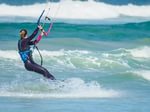By Pamela A. Keene
Friends paddleboard length of Lanier in less than 12 hours
What started out as a wild hair five years ago finally came to pass last month. Chris Wakefield led a pack of friends on a one-day stand-up paddleboard adventure from north of Lake Lanier Olympic Park to the Buford Dam in late July.
“As far back as five years ago a couple of us were sitting around talking about what it would be like to paddleboard the lake from our houses to Port Royale, but we just kept talking about it,” said Wakefield, who is also an avid water-sports athlete and owns The Outdoor Lights. “I did that paddle in June 2015, but then, about the first or second week of July this year, Mike Crawford just said ‘Let’s paddleboard the whole lake. About five of us jumped on the idea and less than 10 days later, that’s what we did.”
On July 23, at 7:04 a.m., five guys set out from Lake Lanier Olympic Park to paddleboard down the lake – Hub Talbot, Hans Daniels, Mike Crawford, Mark Bullock and Wakefield. The group, three from Forsyth County and two from Hall, were determined to complete the challenge.
Crawford’s 17-year-old son Carmichael provided support first on a jet ski and later by boat for most of the trip. “It was Hans’ 40th birthday and he said he needed to do something extraordinary that day, and this was it,” Wakefield said. “The rest of us were just as committed. We had a game plan, including where we’d eat lunch and what we’d do if someone needed to drop out.”
Lunch at ‘Halfway Island’
All of them started out great guns, paddling standing up. The sky was overcast with little breeze and light rain as they made their way southwest. By 12:06 they were at their agreed-upon lunch stop, an island they dubbed “Halfway Island” because it was about halfway between their starting point and the dam. “You could touch the water from both the Chattahoochee and the Chestatee, so it was a good choice.”
Each had packed a lunch, with protein bars, pickle juice to help avoid cramps, sandwich meat and bread. They made sandwiches on the beach. They also carried plenty of water, laced with carb powder for the trip.
“Then a little while later, we decided to have a second lunch, so we paddled over to Port Royale and ate again at Pelican Pete’s,” he said. “By that time we were hungry again, and we needed to pack on lots of carbs for energy.”
Then it was off again. By this time, the sun had broken through the clouds. “The wind picked up, too, right when we turned the corner,” Wakefield said. “We could see Three Sisters Islands, and it was really blowing hard, almost a headwind, and taking us to one side. It made it really tough to paddle.”
They decided to get on their knees and go for a more aerodynamic profiles. “At one point it was surely blowing 18,” he said. “The winds were something we hadn’t really anticipated. And the lake had really big rollers. Somewhere in all that wind, one of the guys said that we really ought to have done this trip kiteboarding.”
Movie crew cheered
But still they persevered. Each paddler kept his PFD close and various friends checked in with them from their boats, just in case. In front of Cocktail Cove, they paddled past a movie crew in boats, who at first asked the paddlers if they needed any help. Once they told the filmmakers their mission, the production folks cheered them on, then went back to work.
By the time they reached the dam at around 6:30, they were all tired, but not exhausted. “I will say this: we were all really hungry,” Wakefield said. They had left a truck at Crawford’s father’s home near the dam so they could get back to their cars at Lake Lanier Olympic Park. “As soon as we got back, we all went out to Blue Fin for sushi and to talk about the day.”
They averaged 2.9 miles per hour over the course of 11 hours and 20 minutes. “I only fell one time, and that’s when we met with all those heavy waves and wind,” Wakefield said. “I could see the dam. The rest of guys did really well. We traveled as a pack and always kept our eyes on each other.”
In the last quarter-mile, Crawford picked up his sister’s three kids, ages 6, 9 and 10, and they rode with him. “It was really fun to have them along and they had a great time,” Crawford said.
They originally planned to break the trip into two days, not having a good gauge of how long it would take. They had several safety discussions before embarking, including bringing PFDs, filing a float plan and staying in touch with their cellphones kept in waterproof bags.
“Our exit plan, if someone felt they had to drop out from being tired or not feeling well, was to paddle to the nearest dock and call Uber or Lyft for a ride back to the cars,” he said. “You know, it never really became an issue, but better to have a plan and not need it, right?”
Next year for charity
When word got around about their trip, other people said they wished they’d participated. One of the paddleboarders said that they should have done this trip to raise money for charity.
Well, that’s what the group intends to do next year. “We want to create a formal event to raise money for the Boys Lodge in Cumming and open it up to the public next year,” Wakefield said. “Most of us were in pretty good shape going into this and other than being tired the next day, it was an amazing adventure.”
Lanier lap record holder heading to Eco Challenge in Fiji this month
By Jane Harrison
The adventure racer who in June paddled the entire outer shoreline of Lake Lanier in six days is heading for an even more daunting journey this month. Josh Forester called his “Lanier Lap” a major milestone leading to the Eco Challenge in Fiji. Deemed “the toughest race in the world,” the expedition runs Sept.10-21 and will air on Amazon TV in 2020. It is being produced by Mark Burnett, originator/producer of Survivor on CBS.
Forester’s four-person squad, US Military, will be among 50 teams covering 350 miles in the non-stop, 24-hour a day, 11-day contest of strength, endurance and skill. According to the Eco Challenge website, the route may include jungle trekking, outrigger paddling, rope climbing, rappelling, pack rafting, paddle boarding, and sailing. Participants must leave their electronics at home and navigate only with a map and compass.
Forester, 37, said he fell into “grand awe and wonder” watching Eco Challenge on the Discovery Channel as a teenager 20 years ago. When he learned last year the event was being revived, he “dropped everything” to train for the “once in a lifetime opportunity” to race it.
He spoke with Lakeside News prior to his Sept. 3 departure for Fiji. Here’s a brief synopsis of that interview, edited and paraphrased.
Q: How was recovery from the Lanier Lap?
Forester: It took longer than I expected. I was off the water six weeks and moved on to mountain biking, hiking, anything that didn’t require my shoulders and arms. My fingertips in my left hand are still numb.
Q: What is the greatest strength you bring to your team?
Forester: Organization. We are all very strong individuals. Half the battle is getting to the starting line. The logistics of acquiring the gear, shipping it to Fiji, flights, training are astounding.
Q: What will be most challenging for you?
Forester: Personally, I run hottest on the team, so hydration is paramount. It’s in a native island environment and will require ocean navigation where there’s no land in sight. I’m intimidated by that. This is my first experience of this nature. None of us is tops at nautical navigation.
Q: It looks really dangerous. Video trailers of past Eco Challenges show participants being dragged by camels, diving off cliffs, slipping on slopes, biking on high ridges, and strapped to stretchers and being helicoptered off. What about the risks?
Forester: There are always risks in the wilderness. Actually, there are more risks involved sitting on a couch and not exercising or getting in a car. We have an ER doctor on our team, plus wilderness first responders. Part of the risk is having to accept the fact that such an endeavor may include traumatic wounds, broken bones, and emergency situations in water. The Eco Challenge crew provides medical services and helicopter transport for emergency situations.
Q: What about nutrition? They’ll be no Lanier Dwellers hauling cupcakes and steaks out to you.
Forester: (Laughs). There are import restrictions on food. We really had to plan ahead.
Q: The top prize in Survivor is $1 million. The Eco Challenge winning team splits $100,000. It looks a lot harder than Survivor. What do you say to that?
Forester: (Laughs) Stakes are always a little higher in (social) politics.
Q: When will we know the results?
Posted online 8.29.19






Recent Comments